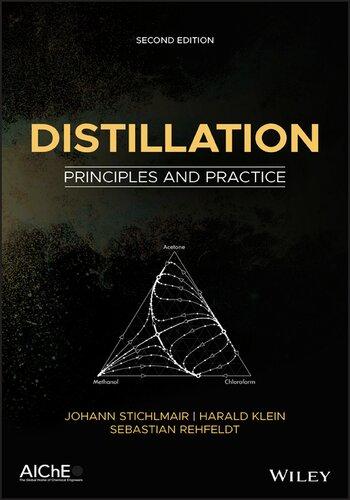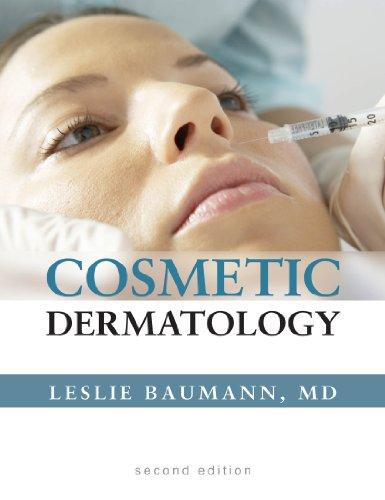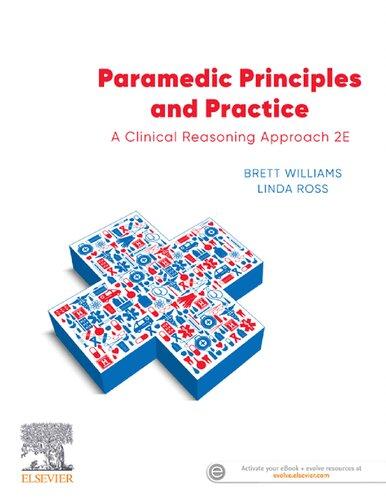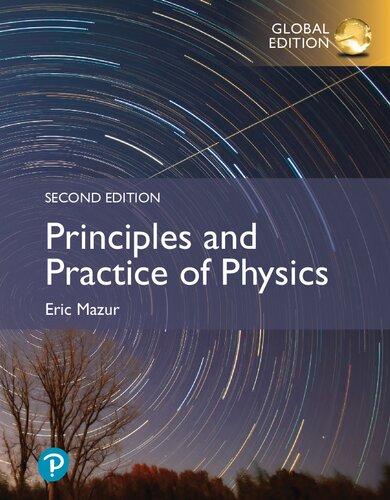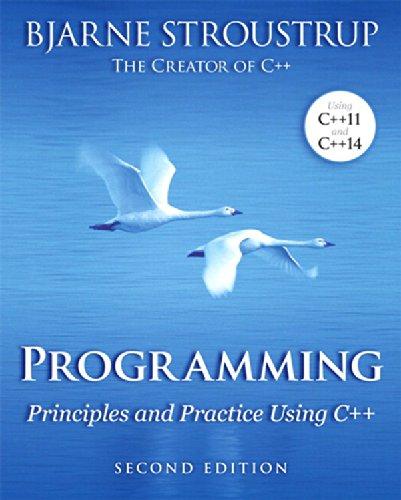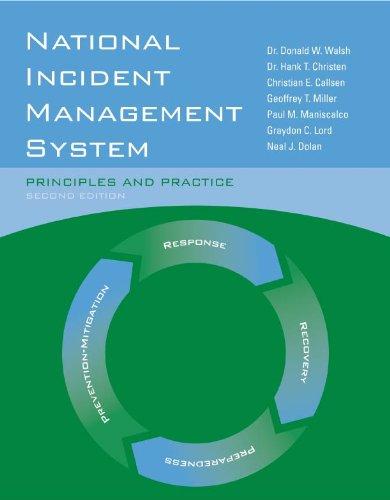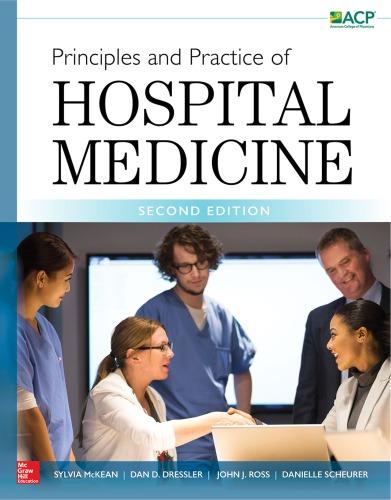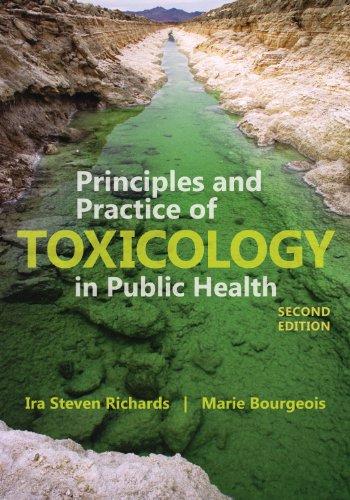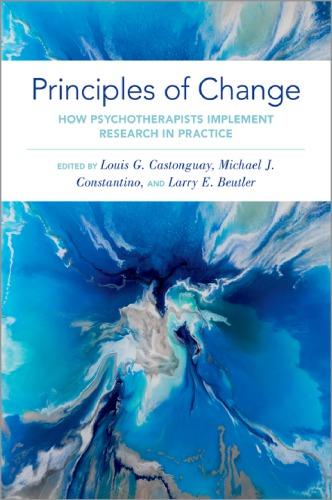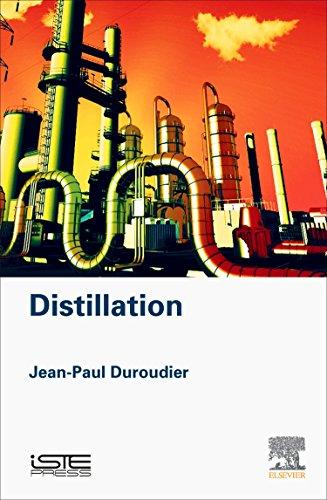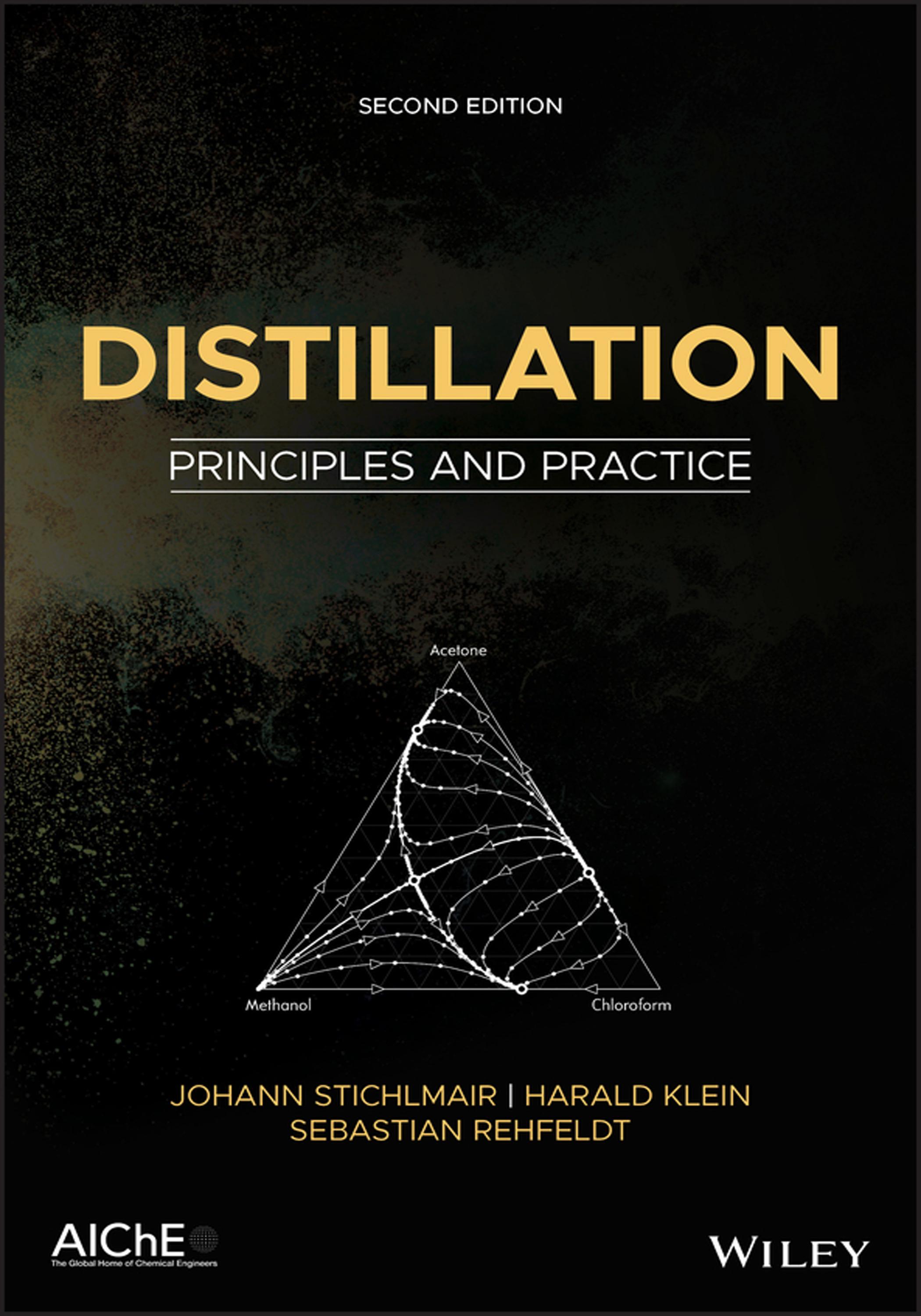DISTILLATION
Principles and Practice
SecondEdition
Prof.Dr.-Ing.JOHANNSTICHLMAIR
Prof.Dr.-Ing.HARALDKLEIN
Dr.-Ing.SEBASTIANREHFELDT
Copyright©2021byAmericanInstituteofChemicalEngineers,Inc.Allrightsreserved. AJointPublicationoftheAmericanInstituteofChemicalEngineersandJohnWiley&Sons,Inc.
PublishedbyJohnWiley&Sons,Inc.,Hoboken,NewJersey.
EditionHistory Wiley-VCH(1e,1998)
Allrightsreserved.Nopartofthispublicationmaybereproduced,storedinaretrievalsystem,ortransmitted, inanyformorbyanymeans,electronic,mechanical,photocopying,recordingorotherwise,exceptas permittedbylaw.Adviceonhowtoobtainpermissiontoreusematerialfromthistitleisavailableat http://www.wiley.com/go/permissions.
TherightofProf.Dr.-Ing.JohannStichlmair,Prof.Dr.-Ing.HaraldKlein,andDr.-Ing.SebastianRehfeldtto beidentifiedastheauthorsofthisworkhasbeenassertedinaccordancewithlaw.
RegisteredOffice
JohnWiley&Sons,Inc.,111RiverStreet,Hoboken,NJ07030,USA
EditorialOffice 111RiverStreet,Hoboken,NJ07030,USA
Fordetailsofourglobaleditorialoffices,customerservices,andmoreinformationaboutWileyproductsvisit usatwww.wiley.com.
Wileyalsopublishesitsbooksinavarietyofelectronicformatsandbyprint-on-demand.Somecontentthat appearsinstandardprintversionsofthisbookmaynotbeavailableinotherformats.
LimitofLiability/DisclaimerofWarranty
Inviewofongoingresearch,equipmentmodifications,changesingovernmentalregulations,andtheconstant flowofinformationrelatingtotheuseofexperimentalreagents,equipment,anddevices,thereaderisurgedto reviewandevaluatetheinformationprovidedinthepackageinsertorinstructionsforeachchemical,pieceof equipment,reagent,ordevicefor,amongotherthings,anychangesintheinstructionsorindicationofusage andforaddedwarningsandprecautions.Whilethepublisherandauthorshaveusedtheirbesteffortsin preparingthiswork,theymakenorepresentationsorwarrantieswithrespecttotheaccuracyorcompleteness ofthecontentsofthisworkandspecificallydisclaimallwarranties,includingwithoutlimitationanyimplied warrantiesofmerchantabilityorfitnessforaparticularpurpose.Nowarrantymaybecreatedorextendedby salesrepresentatives,writtensalesmaterialsorpromotionalstatementsforthiswork.Thefactthatan organization,website,orproductisreferredtointhisworkasacitationand/orpotentialsourceoffurther informationdoesnotmeanthatthepublisherandauthorsendorsetheinformationorservicestheorganization, website,orproductmayprovideorrecommendationsitmaymake.Thisworkissoldwiththeunderstanding thatthepublisherisnotengagedinrenderingprofessionalservices.Theadviceandstrategiescontainedherein maynotbesuitableforyoursituation.Youshouldconsultwithaspecialistwhereappropriate.Further,readers shouldbeawarethatwebsiteslistedinthisworkmayhavechangedordisappearedbetweenwhenthiswork waswrittenandwhenitisread.Neitherthepublishernorauthorsshallbeliableforanylossofprofitorany othercommercialdamages,includingbutnotlimitedtospecial,incidental,consequential,orotherdamages.
LibraryofCongressCataloging-in-PublicationData
Names:Stichlmair,Johann,author.|Klein,Harald,author.|Rehfeldt, Sebastian,author.
Title:Distillation:principlesandpractice/JohannStichlmair,Harald Klein,SebastianRehfeldt.
Description:Secondedition.|Hoboken,NewJersey:Wiley-AIChE,[2021]| Includesbibliographicalreferencesandindex.
Identifiers:LCCN2020024694(print)|LCCN2020024695(ebook)|ISBN 9781119414667(cloth)|ISBN9781119414698(adobepdf)|ISBN 9781119414681(epub)
Subjects:LCSH:Distillation.
Classification:LCCTP156.D5S852021(print)|LCCTP156.D5(ebook)| DDC 660/.28425–dc23
LCrecordavailableathttps://lccn.loc.gov/2020024694
LCebookrecordavailableathttps://lccn.loc.gov/2020024695
Coverimage:©MinaDeLaO/GettyImages CoverdesignbyWiley
Setin9.5/12.5ptTeXGyreTermesbySPiGlobal,Chennai,India 10987654321
2.1.3MolarMixingandPartialMolarStateVariables
2.1.4SaturationVaporPressureandBoilingTemperatureofPureComponents
2.1.5FundamentalEquationandtheChemicalPotential
2.1.6Gibbs–DuhemEquationandGibbs–HelmholtzEquation
2.2CalculationofVapor–LiquidEquilibriuminMixtures
2.2.1BasicEquilibriumConditions
2.2.2GibbsPhaseRule
2.2.3CorrelationsfortheChemicalPotential
2.2.4CalculatingActivityCoefficientswiththeMolarExcessFreeEnergy ................
2.2.5ThermodynamicConsistencyCheckofMolarExcessFreeEnergyandActivity Coefficients
2.2.6Iso-fugacityCondition ..............................................................
2.2.7FugacityoftheLiquidPhase
2.2.8FugacityoftheVaporPhase
2.2.9Vapor–LiquidEquilibriumUsinganEquationofState
2.2.10FugacityofPureLiquidasStandardFugacity:Raoult’sLaw 47
2.2.11FugacityofInfinitelyDilutedComponentasStandardFugacity:Henry’sLaw 48
2.2.12CorrelationsDescribingtheMolarExcessFreeEnergyandActivityCoefficients 49
2.2.13UsingExperimentalDataofBinaryMixturesforCorrelationsDescribingtheMolar ExcessFreeEnergyandActivityCoefficients
2.2.14Vapor–LiquidEquilibriumRatioofMixtures
2.2.15RelativeVolatilityofMixtures
2.2.16BoilingConditionofLiquidMixtures
2.2.17Condensation(DewPoint)ConditionofVaporMixtures
2.3BinaryMixturesandPhaseDiagrams
2.3.1BoilingCurveCorrelation
2.3.3 (
(T , x , y )-Diagram
2.3.5McCabe–ThieleDiagram
2.3.6BoilingandCondensationBehaviorofBinaryMixtures
2.3.7GeneralAspectsofAzeotropicMixtures
2.3.8LimitingCasesofBinaryMixtures
2.4TernaryMixtures
2.4.1BoilingandCondensationConditionsofTernaryMixtures
2.4.5DerivationofDistillationLines
3.1ContinuousClosedDistillationandCondensation
3.1.1ClosedDistillationofBinaryMixtures
3.1.2ClosedDistillationofMulticomponentMixtures
3.2BatchwiseOpenDistillationandOpenCondensation
3.2.1BinaryMixtures
3.2.2TernaryMixtures
3.2.3MulticomponentMixtures
3.3Semi-continuousSingle-StageDistillation
3.3.1Semi-continuousSingle-StageDistillationofBinaryMixtures
4MultistageContinuousDistillation(Rectification)
4.1Principles
4.1.1Equilibrium-StageConcept
4.1.2Transfer-UnitConcept
4.1.3ComparisonofEquilibrium-StageandTransfer-UnitConcepts
4.2MultistageDistillationofBinaryMixtures
4.2.1CalculationsBasedonMaterialBalances
4.2.2CalculationBasedonMaterialandEnthalpyBalances
4.2.3DistillationofBinaryMixturesatTotalRefluxandReboil
4.2.4DistillationofBinaryMixturesatMinimumRefluxandReboil
4.2.5EnergyRequirementforDistillationofBinaryMixtures
4.3MultistageDistillationofTernaryMixtures
4.3.1CalculationsBasedonMaterialBalances
4.3.2DistillationofTernaryMixturesatTotalRefluxandReboil
4.3.3DistillationofTernaryMixturesatMinimumRefluxandReboil
4.3.4EnergyRequirementofTernaryDistillation
4.4MultistageDistillationofMulticomponentMixtures
4.4.1RigorousColumnSimulation
5ReactiveDistillation,CatalyticDistillation
5.1Fundamentals
5.1.1ChemicalEquilibrium
5.1.2StoichiometricLines
5.1.3Non-reactiveandReactiveDistillationLines
5.1.4ReactiveAzeotropes
5.2TopologyofReactiveDistillationLines
5.2.1ReactionsinTernarySystems
5.2.2ReactionsinTernarySystemswithInertComponents
5.2.3ReactionswithSideProducts
5.2.4ReactionsinQuaternarySystems
5.3TopologyofReactiveDistillationProcesses
5.3.1SingleProductReactions
5.3.2DecompositionReactions
5.3.3SideReactions
5.4ArrangementofCatalystsinColumns
5.4.1HomogeneousCatalyst
5.4.2HeterogeneousCatalyst
6MultistageBatchDistillation
6.1BatchDistillationofBinaryMixtures
6.1.1OperationwithConstantReflux
6.1.2OperationwithConstantDistillateComposition
6.1.3OperationwithMinimumEnergyInput
6.1.4ComparisonofEnergyRequirementforDifferentModesofDistillation
6.2BatchDistillationofTernaryMixtures
6.2.1ZeotropicMixtures
6.2.2AzeotropicMixtures
6.3BatchDistillationofMulticomponentMixtures
6.4InfluenceofColumnLiquidHold-uponBatchDistillation
6.5ProcessesforSeparatingZeotropicMixturesbyBatchDistillation
6.5.1TotalSlopCutRecycling
6.5.2BinaryDistillationoftheAccumulatedSlopCuts
6.5.3RecyclingoftheSlopCutsattheAppropriateTime
6.5.4CyclicOperation
6.6ProcessesforSeparatingAzeotropicMixturesbyBatchDistillation
6.6.1ProcessesinOneDistillationField
6.6.2ProcessesinTwoDistillationFields
6.6.3ProcessSimplifications
6.6.4HybridProcesses
7EnergyEconomizationinDistillation
7.1EnergyRequirementofSingleColumns
7.1.1ReductionofEnergyRequirement
7.1.2ReductionofExergyLosses
7.2OptimalSeparationSequencesofTernaryDistillation
7.2.1ProcessandEnergyRequirementofthe
7.2.2ProcessandEnergyRequirementofthe
7.2.3ProcessandEnergyRequirementofthePreferred
7.3ModificationsoftheBasicProcesses
7.3.1Material(Direct)CouplingofColumns
7.3.2ProcesseswithSideColumns
7.3.3Thermal(Indirect)CouplingofColumns
7.4DesignofHeatExchangerNetworks
7.4.1OptimumHeatExchangerNetworks
7.4.2ModifyingtheOptimumHeatExchangerNetwork
7.4.3DualFlowHeatExchangerNetworks
7.4.4ProcessModifications
8IndustrialDistillationProcesses
8.1ConstraintsforIndustrialDistillationProcesses
8.1.1FeasibleTemperatures
8.1.2FeasiblePressures
8.1.3FeasibleDimensionsofColumns
8.2FractionationofBinaryMixtures
8.2.1RecyclingofDilutedSulfuricAcid
8.2.2AmmoniaRecoveryfromWastewater
8.2.3HydrogenChlorideRecoveryfromInertGases
CONTENTS
8.2.4LindeProcessforAirSeparation
8.2.5ProcessWaterPurification
8.2.6SteamDistillation
8.3FractionationofMulticomponentZeotropicMixtures
8.3.1SeparationPaths
8.3.2ProcesseswithSideColumns 431
8.4FractionationofHeterogeneousAzeotropicMixtures
8.5FractionationofAzeotropicMixturesbyPressureSwingProcesses
8.6FractionationofAzeotropicMixturesbyAdditionofanEntrainer 439
8.6.1ProcessesforSystemsWithoutDistillationBoundary
8.6.2ProcessesforSystemswithDistillationBoundary 444
8.6.3HybridProcesses 455
8.7IndustrialProcessesofReactiveDistillation
8.7.1SynthesisofMTBE
8.7.2SynthesisofMono-ethyleneGlycol 471
8.7.3SynthesisofTAME 473
8.7.4SynthesisofMethylAcetate 474
9DesignofMassTransferEquipment
9.1TypesofDesign
9.1.1TrayColumns
9.1.2PackedColumns
9.1.3CriteriaforUseofTrayorPackedColumns
9.2DesignofTrayColumns
9.2.1DesignParametersofTrayColumns
9.2.2OperatingRegionofTrayColumns
9.2.3Two-PhaseFlowonTrays 497
9.2.4MassTransferintheTwo-PhaseLayeronColumnTrays 518
9.3DesignofPackedColumns 533
9.3.1DesignParametersofPackedColumns 534
9.3.2OperatingRegionofPackedColumns 545
9.3.3Two-PhaseFlowinPackedColumns 549
9.3.4MassTransferinPackedColumns 568
9.AAppendix:PressureDropinPackedBeds 587
10ControlofDistillationProcesses 601
10.1ControlLoops 602
10.1.1SingleControlLoop 602
10.1.2RatioControlLoop 604
10.1.3DisturbanceFeedforwardControlLoop 604
10.3.1BasicControlSystemsWithoutCompositionControl
10.3.2One-PointCompositionControlConfigurations
10.4.2SharpSeparationsofIdealMixtureswithConstantRelativeVolatilityatMinimum RefluxandBoilupRatio
10.4.3ExtendedApplicationRangesoftheBasicControlConfigurations
10.5.4AzeotropicDistillationProcessbyUsinganEntrainer
Preface
Distillationisthemostimportantandthemosteffectivetechnologyforthefractionationofmulticomponentmixtures.Fieldsofapplicationareallbranchesoftheprocess industry,forinstance,petroleumrefineries,chemicalindustries,andfoodindustries. Theoftenverytalldistillationtowersdominatetheviewofmanychemicalsites.Accordingtoitsgreatimportance,distillationisahighlydevelopedtechnology.
Thefundamentalmechanismofdistillationisthemasstransferbetweenagaseous andaliquidphase.Thedrivingforceforthisinterfacialmasstransferisthedifference betweentheactualandtheequilibriumconcentrationofthephases.
Thebookconsistsof10chapters.Chapter1dealswiththebasicprincipleofdistillationandwithsomehistoricalaspectsoftheart.
Chapter2concentratesonthethermodynamicsofvapor–liquidequilibrium,since agoodknowledgeofvapor–liquidequilibriumisanindispensableprerequisiteforthe designofdistillationprocesses.Ascomparedtomanyothertextbooks,themixtures arenotlimitedtotwocomponents,butternarymixturesalongwiththeirboiling surfacesandtriangulardiagramsareconsidered.
TheChapters3–6dealwiththethermodynamicsofsingle-stagedistillation (Chapter3)andmulti-stagedistillation(Chapter4),whichisoftencalledrectification,reactivedistillation(Chapter5),andbatchdistillation(Chapter6).Special attentionisgivenasdescribedabovetoternarymixtures,sincetheyrepresentamore generalcasethanbinarymixturesmosttextbooksondistillationfocuson.
InChapter7theenergyrequirementofdistillationprocessesisdiscussed.This chapterdemonstrateshowthelargeenergyrequirementofdistillationprocessescan bedrasticallyreducedbyinternalcolumncouplingandintelligentprocessmodifications.
ImportantexamplesofindustrialdistillationprocessesarepresentedinChapter8. Here,specialattentionisgiventoprocessesforthefractionationofazeotropicmixtures.
ThedesignofdistillationcolumnsistreatedinChapter9withfocusontray columnsandpackedcolumns.Finally,thecontrolofdistillationcolumnsisthe objectiveofChapter10wheretheconceptofsplitstreamcontrolisapplied.
Theprimeintentionofthistextbookistoletthereaderdevelopadeepunderstandingoftheartofdistillation.Manyfullyworkedoutexamplesdemonstratetheeasy applicabilityofthetheoreticalfindings.Theseexamplesarearrangedinboxesto
facilitatethereadabilityofthetext.
Ofcourse,notonlytheauthorsareinvolvedinthecompletionofsuchacomprehensivebook.Atthispointwewouldliketothankeveryonewhocontributedtothesuccessofthisproject:FelicitasEngel,M.Sc.,PhilippFritsch,M.Sc., PatrickHaider,M.Sc.,FlorianHanusch,M.Sc.,RobertKender,M.Sc.,ThomasKleiner,M.Sc.,MaximilianNeumann,M.Sc.,Dr.-Ing.AnnaReif,MarcXia,M.Sc., AlexanderEder,B.Sc.,FlorianKaufmann,M.Sc.,andJanOettig,B.Sc.,aswellas thevaluableexpertiseofDr.-Ing.VolkerEngel.ManythanksalsotoStephanKorell forhishelpfuladviceontheLATEXimplementation.
JohannStichlmair, HaraldKlein, SebastianRehfeldt
Munich,February2020
Nomenclature
LatinSymbols
a lowboiler –
a specificsurfacearea m2/m3
aeff specificeffectiveinterfacialarea m2/m3
a/v2 cohesionpressurevanderWaalsequation Pa
a coefficientcubicequationofstateofmixture J m3/kmol2
aii coefficientcubicequationofstateofpurecomponent i J · m3/kmol2
aij crosscoefficientcubicequationofstateofcomponent i and j J · m3/kmol2
ai activityofcomponent i –
A area m2
Ai AntoineorWagnerparameterofcomponent i –
Aij binaryparameterMargulesandvanLaarequationofcomponent i and j –
b highboiler(binarymixture)orintermediate boiler(ternarymixture) –
b constant –
b co-volumevanderWaalsequation m3
b coefficientcubicequationofstateofmixture m3/kmol
bi coefficientcubicequationofstateofpurecomponent i m3/kmol
B moleamountofbottomproduct kmol
B widthofpackingchannelbase m ˙
B bottomflowrate kmol/s
B virialcoefficientofmixture m3/kmol
NOMENCLATURE
Bi AntoineorWagnerparameterofcomponent i –
Bii virialcoefficientofpurecomponent i m3/kmol
Bij crossvirialcoefficientofcomponent i and j m3/kmol
c highboiler(ternarymixture)orintermediate boiler(quaternarymixture) –
c specificormolarheatcapacity J/(kg K) J/(kmol K)
c,C constant –
C secondmixturevirialcoefficientofmixture m6/kmol2
Ci AntoineorWagnerparameterofcomponent i –
CG capacityfactor m/s
Ch empiricpackingfactor –
d highboilerquaternarymixture –
d diameter,distance m
D diameter m
D diffusioncoefficient m2/s
D moleamountofoverheadproduct(distillate) kmol
˙ D overhead(distillate)flowrate kmol/s
DE dispersioncoefficient(eddydiffusioncoefficient) m2/s
Di Wagnerparameterofcomponent i –
e entrainer –
EOG overallgas-sidepointefficiency –
EOGM overallgas-sidetrayefficiency –
E exergy J
f frictionfactor –
fi fugacityofcomponent i Pa
f 0 i standardfugacityofcomponent i Pa
FF -factor(gasload) Pa0 5
F moleamountoffeed kmol
F feedflowrate kmol/s
Fi surfaceareafraction/molefractionUNIQUAC equationofcomponent i –
g gravitationalacceleration g =9.81m/s2 m/s2
g molarGibbsfreeenergy J/kmol
gi gasflowrateofcomponent i kmol/s
gi partialmolarGibbsfreeenergyofcomponent i J/kmol
NOMENCLATURE
∆g molarmixingGibbsfreeenergy J/kmol
gE molarexcessfreeenergy J/kmol
gE i partialmolarexcessfreeenergyofcomponent i J/kmol
∆gij binaryparameterNRTLequationofcomponent i and j –
G moleamountofvapor kmol
˙ G gas/vaporflowrate kmol/s
G Gibbsfreeenergy J
GE excessfreeenergy J
Gij binaryparameterNRTLequationofcomponent i and j –
h specificormolarenthalpy J/kg J/kmol
hi partialmolarenthalpyofcomponent i J/kmol
∆h molarmixingenthalpy J/kmol
h height m
hdyn dynamichold-up
m3/m3
hdyn0 dynamichold-upbelowloadingpoint m3/m3
hf frothheight m
hL clearliquidheight m
hL liquidhold-up m3/m3
hp heightofpressuredrop m
hstat statichold-up m3/m3
hw weirheight m
H enthalpy J
˙ H enthalpyflowrate W
H trayspacingorpackingheight m
Hij Henrycoefficientofcomponent i incomponent j Pa
HL molarhold-upofliquid kmol
HETP heightequivalenttoonetheoreticalplate m
HTU heightofatransferunit m
J strippingfactor –
k numbersofcomponentsinmixture –
k masstransfercoefficient kmol/(m2 s)
kij binaryparametercubicequationofstateof component i and j –
NOMENCLATURE
Ki vapor–liquidequilibriumratioofcomponent i –
KR reactionequilibriumconstant –
l (path)length m
li liquidflowrateofcomponent i kmol/s
L amountofliquid kmol
L liquidflowrate kmol/s
Lp wettedperimeter m
m slopeofequilibriumcurve –
m exponent –
M mass kg
M moleamountofmixtureinthemiddlevessel kmol
ˆ M molecularweight kg/kmol
˙ M mixtureflowrate kmol/s
n numberofequilibriumstages –
n exponent –
N moleamount kmol
N molarflowrate kmol/s
NTU numberoftransferunits –
p pitch m
p pressure Pa
pi partialpressureofcomponent i Pa
p0 i saturationvaporpressureofpurecomponent i Pa
p+ referencepressure Pa
Ph numberofphases –
Poy i Poyntingcorrectionofcomponent i –
qi relativevanderWaalssurfaceUNIQUACequationofcomponent i –
qF caloricfactor(thermalstate)ofthefeed –
Q heat J
Q dimensionlessconcentrationchange –
Q heatflow W
ri relativevanderWaalsvolumeUNIQUACequationofcomponent i –
r molarlatentheatofvaporization J/kmol
ˆ R idealgasconstant ˆ R =8314J/(kmol · K)J/(kmol · K)
R reactoreffluentflowrate kmol/s
RG externalreboil(boilup)ratio –
NOMENCLATURE
RL externalrefluxratio –
s molarentropy J/(kmol K)
s platethickness m
S lengthofpackingchannelside m
˙ S molarflowrateafterdecanter,sideproduct kmol/s
S entropy J/K
S correctionfactor(Example2.2) –
t time s
T temperature K
T 0 i boilingtemperatureofpurecomponent i K
u superficialvelocity m/s
∆uij binaryparameterUNIQUACequationofcomponent i and j –
U internalenergy J
v molarvolume m3/kmol
vi partialmolarvolumeofcomponent i m3/kmol
∆v molarmixingvolume m3/kmol
V volume m3
˙ V volumetricflowrate m3/s
Vi volumefraction/molefractionUNIQUACequationofcomponent i –
wi mass(weight)fractionofcomponent i –
wiG massfractionofcomponent i ingasphase kg/kg
wiL massfractionofcomponent i inliquidphase kg/kg
W work J
xi molefractionliquidphaseofcomponent i –
xi transformedmolefractioncompletechemical reactionofcomponent i –
X function
Xi transformedconcentrationofcomponent i in reactivesystems –
yi molefractionvaporphaseofcomponent i –
yi estimatedmolefractionvaporphaseofcomponent i (Example2.3)
z numberofinteractingmoleculesUNIQUAC equation –
NOMENCLATURE
z numberofparticlesorchannels –
z locus,dimensionlesstraylength –
zi molefractiontwo-phasemixtureofcomponent i –
Z compressibilityfactor –
Zf numberofindependentstatevariables(degrees offreedom) –
GreekSymbols
α dischargecoefficient –
αi(T ) temperaturefunctioncubicequationofcomponent i –
αij non-randomnessfactorNRTLequationofcomponent i and j –
αij relativevolatility(separationfactor)ofcomponent i and j –
β masstransfercoefficient m/s
γL liquid-phasedistribution –
∆ difference
∆p pressuredrop Pa
∆ densitydifference kg/m3
∆SgE sumofsquaresfor gE J2/kmol2
∆λij binaryparameterWilsonequationofcomponent i and j –
ε porosity,voidage,relativecontent –
ζ dragcoefficient,orificecoefficient –
ζE frictionfactorinErgunequation –
η dynamicviscosity Pa s
ϑ contactangle °
π poleontheenthalpy–concentrationdiagram J/mol
π circleconstant π =3.14159 –
Λij binaryparameterWilsonequationofcomponent i and j –
µi chemicalpotentialofcomponent i J/kmol density kg/m3
σ surfacetension kg/s2
NOMENCLATURE
τ contacttime s
τL liquidresidencetimeinthetwo-phaselayer s
ϕ relativefreeareaofatray –
ϕi fugacitycoefficientofcomponent i
φj correctionfactorofcomponent i
Φ Underwoodparameter
Φfl floodingfactor –
γi activitycoefficientofcomponent i
γ∞ i activitycoefficientatinfinitedilutionofcomponent i
νi stoichiometriccoefficientofcomponent i
ωi acentricfactorofcomponent i
τij binaryparameterNRTLandUNIQUACequationofcomponent i and j
Subscripts
a lowboiler
ac active
azeo azeotrope
b highboiler(binarymixture)orintermediateboiler(ternarymixture)
B bottomproduct
c highboiler(ternarymixture)orintermediateboiler(quaternary mixture)
c criticalstatevariable
c column
c continuousphase
cap bubblecap
cl clearanceunderdowncomer
cr critical
C condenser,cooling
d highboilerquaternarymixture
d dispersedphase
d downcomer
d dry
D overheadproduct(distillate)
e end
e entrainer
eq equivalent
E entrainment
Exp experimentalvalue
f froth
fl flooding
F feed
Fr Froudenumber
G gas
h hole
h hydraulic
H heating
irr irrigated
j stagenumber
k numberofcomponents
lam laminar
L liquid
m intermediate
m mean
max maximum
min minimum
n numberofplatesorsteps
n nominal
o openings
o overflow
OG overallgasphase
OL overallliquidphase
p particle
P pinchpoint
r residual
r reducedstatevariable(relatedtocriticalstatevariable)
R reboiler
s packingsection
s particleswarm
S solid
SP sidepinch
NOMENCLATURE
NOMENCLATURE
t plate/tray
turb turbulent
T transitionpoint
vc venacontracta
v valve
w weir
α start
ω end
0 orifice,singleparticle
∞ infinity
Superscripts
0 purecomponent
azeo azeotrope
C combinatorialpartUNIQUACequation
E excessstatevariable id idealgas id0 pureidealgas
n iterationsteporstepondistillationline new newestimate(Example2.3)
R residualpartUNIQUACequation liquidphase vaporphase
ˆ molar
∗ equilibriumstate modified
Abbreviations
A-1absorber
C-1column
E-1heatexchanger,extractor
R-1reactor
S-1decanter
DimensionlessNumbers
Bo = g σ · a2
Fr = u2 g d
Pe = l2 D · τ
Re = u d η
Sc = η D
We = u2 d σ
Bondnumber
Froudenumber
Pecletnumber
Reynoldsnumber
Schmidtnumber
Webernumber
NOMENCLATURE
1 Introduction
Distillationisawidelyusedmethodforseparatingliquidmixturesintotheircomponents.Itistheworkhorseforseparationinthepetroleum,petrochemical,chemical, andrelatedindustries.Theconsensusisthatitwillcontinuetodominatetheseindustriesinthefuture,too.
1.1PrincipleofDistillationSeparation
Distillationutilizesaverysimpleseparationprinciple:anintimatecontactiscreated betweenthestartingmixtureandasecondphaseinordertoenhanceaneffective masstransferbetweenthesetwophases.Thethermodynamicconditionsarechosen sothatprimarilythecomponenttobeseparatedfromthefeedmixtureentersthe secondphase.Thephasesaresubsequentlyseparatedintotwosinglephaseswith differentcompositions.
Threestepsarealwaysinvolvedintheimplementationofthisseparationprinciple; seeFigure1.1:
Figure1.1Generalprincipleoffractionationinthermalseparationtechnology.The essentialmechanismisthemasstransferbetweentwophases.
Distillation: Principles and Practice, Second Edition. Johann Stichlmair, Harald Klein, and Sebastian Rehfeldt. © 2021 American Institute of Chemical Engineers, Inc. Published 2021 by John Wiley & Sons, Inc.
1INTRODUCTION
• Generationofatwo-phasesystem
• Masstransferacrosstheinterface
• Separationofthephases
Manyseparationtechniquesutilizethisveryeffectiveseparationprinciple.Absorption,desorption,evaporation,condensation,anddistillationinvolveagaseousanda liquidphase.Solventextractionusestwoliquidphases.Separationtechniquesthat utilizeafluidphaseandasolidphaseincludeadsorption,crystallization,drying,and leaching.Inmostoftheseseparationprocesses,thenecessarytwo-phasesystemis generatedbyaddinganauxiliaryphasetothefeedmixture.Thesubstancestobe separatedcollectindilutedformintheauxiliaryagent.Indistillation,however,the secondphaseiscreatedbypartialvaporizationoftheliquidfeed.Hence,theuseof anauxiliarysubstance(oftencalledamassseparatingagent),whichrequirescostly recovery,isavoided,andthecomponentstobeseparatedarerecoveredasrelatively puresubstances.Indeed,distillationrequiresonlyenergyintheformofheat,which cansubsequentlybeeasilyremovedfromthesystem.Thisisanimportantadvantage ofdistillation.
Inpractice,distillationrequiresintimatecontactingofvaporandliquidundersuch conditionsthatthedesiredcomponentsoftheliquidenterthevaporphase.Governingtheseconditionsisthevapor–liquidequilibrium.Manyactivitiesontheart ofdistillationaredevotedtofindouthowcloselythevapor–liquidequilibriumcan beapproached.Inanycase,itisnecessarytoseparatetheliquidandvaporphases afterward.
Thevaporandliquidarebroughtintointimatecontactbycountercurrentorcrosscurrentflow,andmassexchangeoccursbecausethetwophasesarenotinthermodynamicequilibrium.Thephasesproducedduringdistillationareformedbyevaporationandcondensationoftheinitialmixture.Theseparationprocesscanbecontrolled onlybytheheatsupply.
Thebasisforplanningdistillationprocessesistheknowledgeofthevapor–liquid equilibrium.Asstatedearlier,theseparationdependsprimarilyontheconcentration oftheindividualsubstancesinthevaporandliquidphases.Inthisbook,principlesof vapor–liquidequilibriumarediscussedinChapter2,withspecialattentiongivento theequilibriumofternaryandmulticomponentmixtures.Thermodynamicanalysis ofdistillationandrectificationisessentialtoestablishtheoptimalconditionsformass transfer.Thedecisivefactoristhedrivingforceformasstransfer,i.e.thedifference betweentheactualconcentrationsofthesubstancesandtheirequilibriumconcentrations.Operatingconditionshavetoensurethatthisdifferenceissufficientlylarge. Appropriaterelationshipsandmethodsfordeterminingmasstransferaredescribed inChapters3–6.ExamplesofindustriallyimportantseparationprocessesandenergyrequirementarediscussedinChapters7and8,respectively.Sinceseparationis achievedbybringingthetwophasesintointimatecontact,inpractice,theproblems createdbymultiphaseflowandmasstransferbetweenphasesmustbeconfronted. Thestateoftheartofmultiphaseflowispresentlyratherpoor.Two-phaseandmultiphaseflowisanunderdevelopedfieldoffluidmechanics.Asaresult,justempirical approachesarepresentlyavailableforpracticalequipmentdesign,asdescribedin
Chapter9.Chapter10dealswiththecontrolofsingledistillationcolumnsandof distillationprocesses.
1.2Historical
Althoughseveralauthors(e.g. Krell 1958)supporttheviewthattheartofdistillationhasbeenwellknowntoancientGreece,thisopinionhasneverbeenproven byhistorians.Ancientphilosophershavebeen,however,veryclosebythecorrect understandingoftheprinciplesofdistillation,forinstance,atthemerephilosophical debateonthecirculationofwaterinnature.Aristoteles(384-322 BCE)writesinhis Meteorologia:"...severalauthorssupportasimilarviewontheoriginofrivers.The waterelevatedbythesunandasraincondensedhumiditycollects...".Inthesame book,hewriteslateron:"Thatevaporatedseawaterisdrinkableand,aftercondensation,doesnotbecomeseawateragain,thatcanwestatefromexperience."However, nopracticalapplicationsofthesetheoreticalconsiderationshavebeenreported,and nodeviceforperformingtheprocessofdistillationisdescribedinancientliterature. AncientEgyptandancientChinaaswellhadprobablynoknowledgeoftheartof distillation. Forbes 1970agreeswithseveralotherauthors(e.g. Underwood 1935) intheopinionthattheartofdistillationhasbeeninventedandpioneeredinusein Alexandria,Egypt,inthefirstcentury CE

Figure1.2Distillationandrectificationequipmenttakenfrom TheAlchemyofAndreas Libavius [Libavius 1964]:(a)boiler,(b)oven,(c)coolers,(d)receiver,(e)headpiece,and (f)receiver.
Inthefollowingcenturiestheknowledgeofdistillationspreadwidelyandwasused aroundtheeleventhcenturyforthefirsttimeinnorthernItalytoproducealcoholic beverages.Thedevelopmentofdistillationequipmenthasbeeninfluencedtremendouslybythisspecialfieldofapplication.Aninterestingdistillationequipment,de-
1INTRODUCTION
scribedinthebook TheAlchemyofAndreasLibavius,publishedin1597,isillustrated inFigure1.2[Libavius 1964];itwasusedforthebatchdistillationofalcohol.
Heatissuppliedtotheliquidcontentsoftheboiler(a),builtintotheoven(b),and thevaporformedwasallowedtocondenseintwocoolers(c).Coolingwaterwas changedperiodically.Theonlyvisibleprocesswasthedrippingofthecondensate intothereceiver(d).ThisseparationtechniquewasnamedaftertheLatinworddestillare,whichmeans"drippingortricklingdown".Eveninearlytimes,itwaswell knownthatahigheralcoholcontentcouldbereachedbyusingaseconddistillation step.IntheapparatusshowninFigure1.2,twodistillationscouldbecarriedoutsimultaneously.Condensatefromthefirstdistillationisreturnedtotheheadpiece(e), theso-calledrectificatorium,whichisheatedwithvaporrisingfromtheboiler.The vaporproducedintheheadpieceiscondensedinthetwocoolers(c).Aliquidwith ahigheralcoholcontentisthencollectedinasecondreceiver(f).Thetermrectificationisderivedfromthisprocess,which,especiallyinEurope,isusedtodescribe multistagedistillation.TheLatinwordsrectefaceremean"torectifyorimprove". Indeed,uptothisday,termrectificationreferstoaprocessbywhichafurtherconcentrationchangeisachievedafterthefirstevaporationstep.
Fromsuchdevicesdistillationcolumnshavebeenfinallydevelopedduringthe followingcenturies.Manyauthors(e.g. Underwood 1935; Forbes 1970)agree ingivingthecreditofinventiontotheFrenchmanCellier-Blumenthal[CellierBlumenthal 1818].Interestingarethecircumstancesthatenhancedthedevelopmentofimproveddistillationdevices.
In1807NapoleonorganizedablockadeagainstEngland,whichansweredbya blockadeagainsttheEuropeancontinent.Inconsequence,goodsfromtheoversea coloniesnolongerreachedEurope,whichresultedinshortagesofsugarcane,among manyothergoods.Itwaswellknownthatsugarcanbeproducedfrombeetsgrown inEuropeaswell[Ullmann 1969].However,thebrownsugarfrombeetswasmuch lessattractivetothenoblementhanthewhitesugarfromcanes.Napoleonopened acompetitionforproducingwhitesugarfrombeetsbysettingaveryhighprize. Afavorableprocesswasextractionofsugarfromthebeetsbyalcoholinsteadof water–aprocessproposedagaininrecentyears[Ullmann 1969].Thealcoholwas recycledwithinthisprocess.However,afterlongerperiodsofoperationtime,the alcoholneededpurificationsincesomewateraccumulatedinthealcohol.CellierBlumenthaldevelopedthefirstdistillationcolumn(atraycolumn)forthisprocess.
Inthenineteenthandtwentiethcenturies,theartofdistillationdevelopedrapidly promptedbytheoilandpetrochemicalindustry[Deibele 1992]andbythechemicalandpharmaceuticalindustry[Fair 1984].Thepresentimportanceofdistillation isdocumentedbythefactthatapproximately 40000 distillationcolumnsareunder operationintheUnitedStates[HumphreyandSeibert 1992].Thesecolumnsconsumeabout 3% ofthetotalenergyrequirementoftheUnitedStates[Gmehling etal. 1994].
REFERENCES 5
References
Cellier-Blumenthal,J.B.(1818).Brevet d’inventionetdeperfectionnementde quinzeans,pourdesappareilsdestinésàla distillationcontinueetàl’évaporation. FrenchPatentNo.2266.
Deibele,E.(1992).DieEntwicklungder Destillationstechnikim19.Jahrhundert. PhDthesis.TechnicalUniversityofMunich. Fair,J.R.(1984).Historicaldevelopmentof distillationequipment. AIChESymposium Series 79(235):1–14. Forbes,R.J.(1970). AShortHistoryoftheArt ofDistillation.Leiden:E.J.Brill. Gmehling,J.,Menke,J.,Krafczyk,J.,and Fischer,K.(1994). AzeotropicData,PartI andII.Weinheim:VCHPublishers. Humphrey,J.L.andSeibert,A.F.(1992).New
horizonsindistillation. Chemical Engineering 99(12):86. Krell,E.(1958). Handbuchder Laboratoriumsdestillation.Berlin:VEB DeutscherVerlagderWissenschaften. Libavius,A.(1964). DieAlchemiedesAndreas Libavius.EinLehrbuchderChemieausdem Jahre1597.Weinheim:VerlagChemie. Ullmann,F.(1969). UllmannsEnzyklopädie derTechnischenChemie,vol.19,p.201and p.217.MünchenBerlinWien:Urban& Schwarzenberg. Underwood,A.J.V.(1935).Thehistorical developmentofdistillingplant. Transactions –InstitutionsofChemicalEngineers 13: 34–63.
